A block of mass m and α pan of equal mass are connected by a string going over a smooth light pulley as shown in figure. Initially the system is at rest when a particle of mass m falls on the pan and sticks to it. If the particle strikes the pan with a speed v find the speed with which the system moves just after the collision.
Let the required sped be V. Further let J1 be the impulse between the particle and the pan and J2 be the impulse imparted to the block and the pan by the string. Using impulse as the change in momentum we have the following equation.
For particle J1=mv−mV........i
For pan J1−J2=mV ...........ii
For block J2=mV..........iii
Solving eqn i - iii we get V=v/3
Topper's Solved these Questions
- BOOK - CENGAGE PHYSICSCHAPTER - CENTRE OF MASSEXERCISE - Solved Examples13videos
CENTRE OF MASS
- BOOK - CENGAGE PHYSICSCHAPTER - CENTRE OF MASSEXERCISE - Exercise 1.120videos
CENTRE OF MASS
- BOOK - CENGAGE PHYSICSCHAPTER - CALORIMETRYEXERCISE - Solved Example13videos
CALORIMETRY
- BOOK - CENGAGE PHYSICSCHAPTER - DIMENSIONS & MEASUREMENTEXERCISE - Integer2videos
DIMENSIONS & MEASUREMENT
Similar Questions
A body of mass 1kg initially at rest, explodes and breaks into three fragments of masses in the ratio 1:1:3. The two pieces of equal mass fly off perpendicular to each other with a speed of 15ms−1 each. What is the velocity of the heavier fragment?
04:09View SolutionTwo children A and B of same mass (including their caps) M are sitting On a see-saw as shown in Fig. Initially, the beam is horizontal. At once, child B throws away his cap (mass M25) which falls at point Q, midpoint of the left half of the beam, due to this the balance of beam is disturbed. To balance it again what is the mass in required to be put at point P on the right half of the beam?
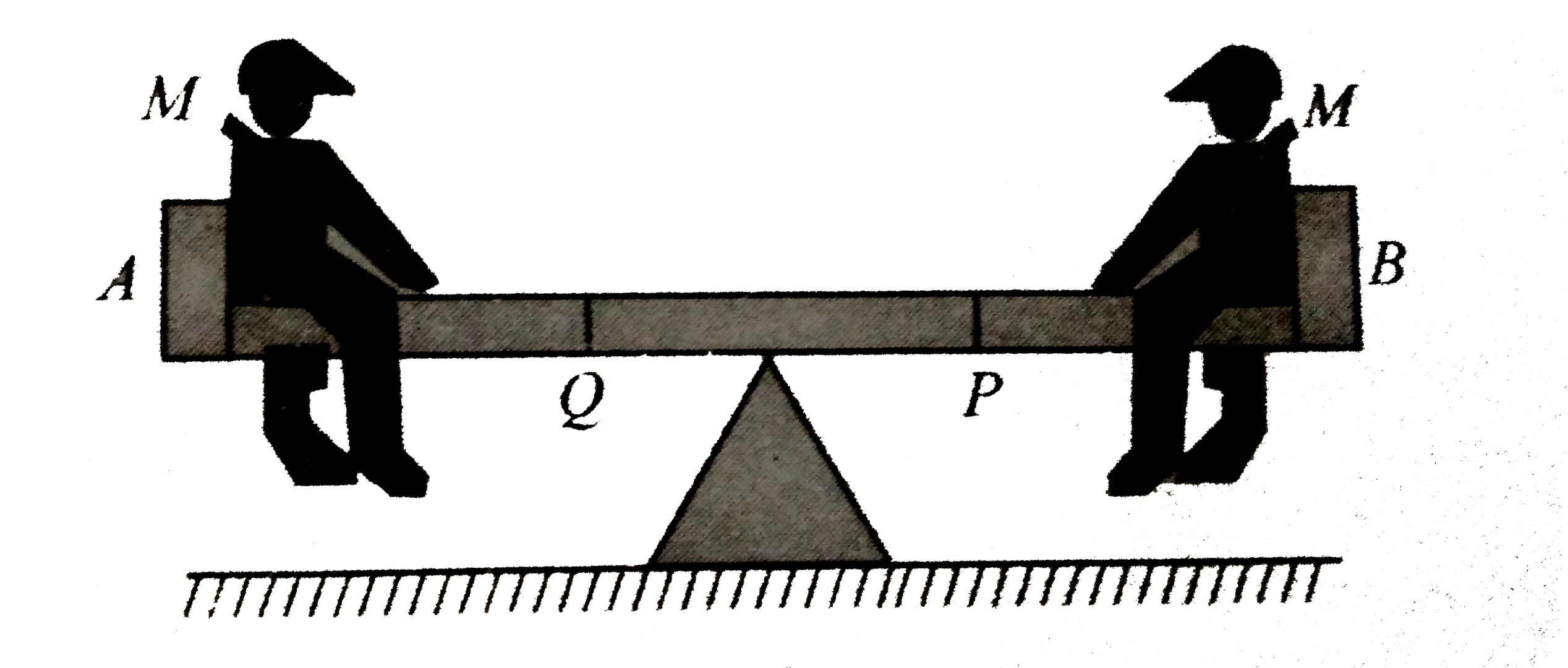 07:42View Solution
07:42View SolutionA colorimeter contains 400g of water at a temperature of 5∘C. Then, 200g of water at a temperature of +10∘C and 400g of ice at a temperature of −60∘C are added. What is the final temperature of the contents of calorimeter?
Specific heat capacity of water −1000 cal/kg/K
Specific latent heat of fusion of ice =80×1000 cal/kg
Relative specific heat of ice =0.507:42View SolutionTo find the distance d over which a signal can be seen clearly in foggy conditions, a railways-engineer uses dimensions and assumes that the distance depends on the mass density ρ of the fog, intensity (power/area) S of the light from the signal and its frequency f. the engineer finds that d is proportional to S1/n. the value of n is
01:35View SolutionA block of mass m and α pan of equla mass are connected by a string going over a smooth light pulley as shwon in figure. Initially the systemis at rest when a particle of mass m falls on the pan and sticks to it. If the particle strikes thepan witha speed v find the speed with which the system moves just after the collision.
03:27View SolutionA pan of mass m=1.5kg and a block of mass M=3kg are connected to each other by a light inextensible string, passing over a light pulley as shown in Fig. Initially, the block is resting on a horizontal floor. A ball of mass m0=0.5kg collides with the pan at a speed v0=20m/s. Consider this instant of collision as t=0. Assume collision to be perfectly inelastic. Now, Fig. answer the following questions based on the above information.
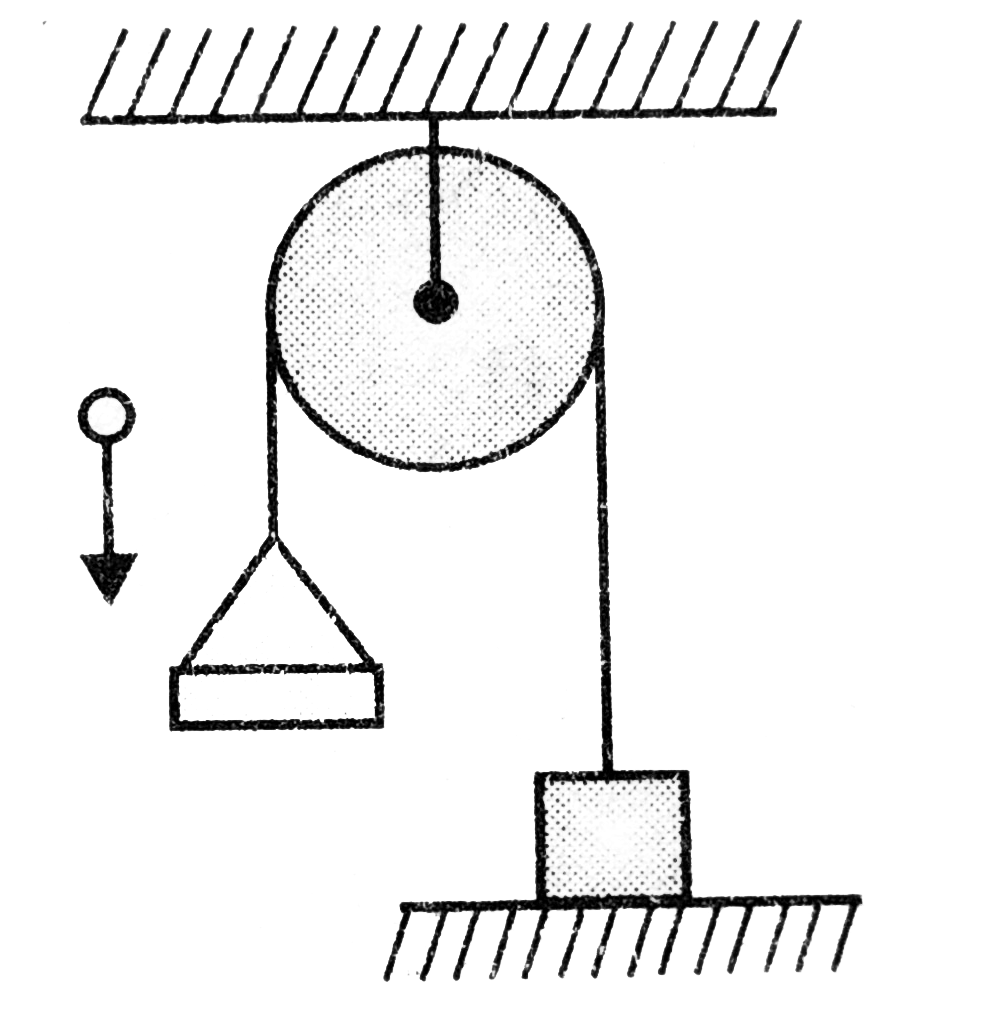
Find the velocity of pan + ball system at t=2.6s. Assume that the block comes to rest instantaneously after striking the floor.03:27View SolutionA pan of mass m=1.5kg and a block of mass M=3kg are connected to each other by a light inextensible string, passing over a light pulley as shown in Fig. Initially, the block is resting on a horizontal floor. A ball of mass m0=0.5kg collides with the pan at a speed v0=20m/s. Consider this instant of collision as t=0. Assume collision to be perfectly inelastic. Now, Fig. answer the following questions based on the above information.
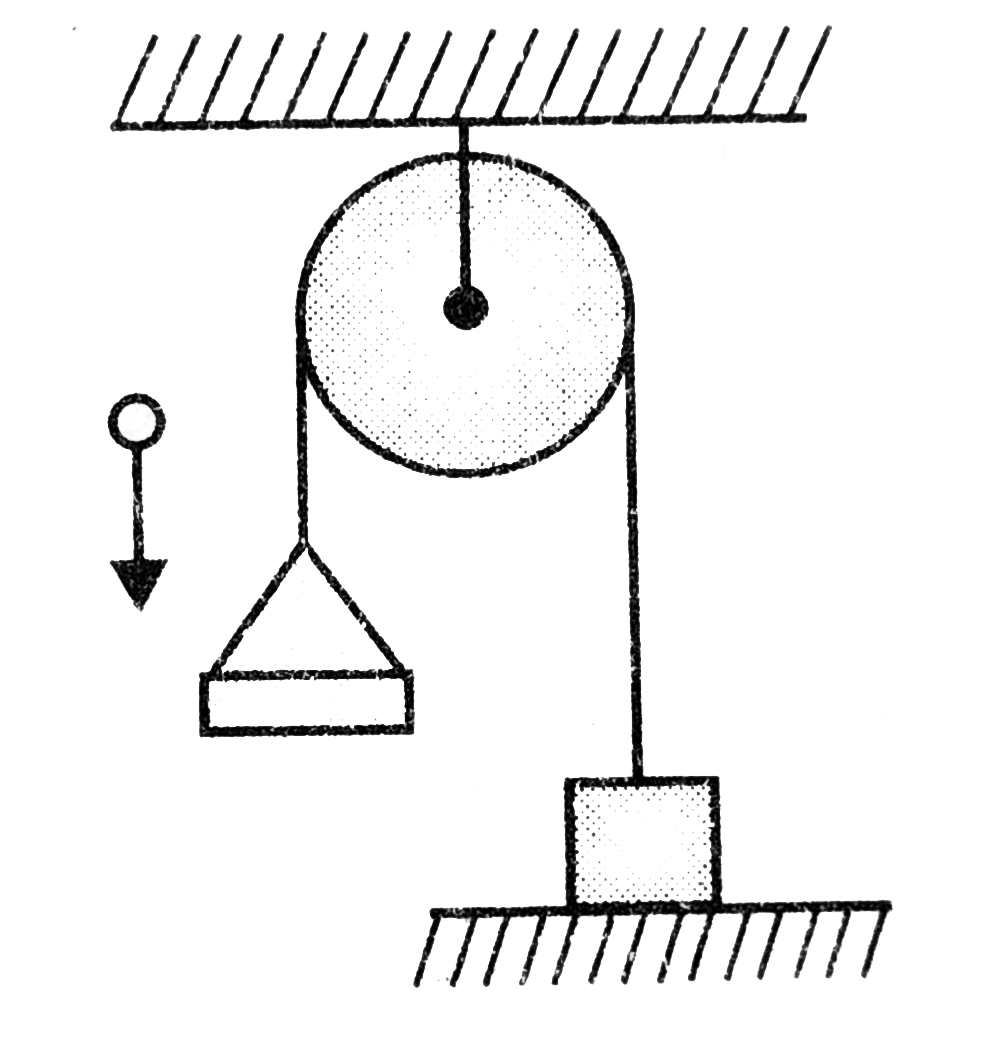
. Find the maximum height reached by the block alter the second jerk.05:54View SolutionA particle of mass m moving with velocity v strikes a stationary particle of mass 2 m and sticks to it. The speed of the system will be.
04:40View SolutionA particle of mass m collides elastically with the pan of mass (M = 2m) of a spring balance, as shown in figure. Pan is in equillibrium before collision. Spring constant is k and speed of the particle before collision is v0 . Answer the following three questions regarding this collision.
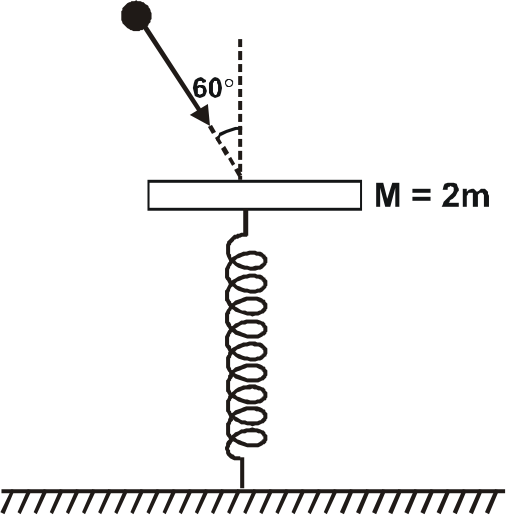
Maximum compression in the spring after the collision the04:19View SolutionA particle of mass m collides elastically with the pan of mass (M = 2m) of a spring balance, as shown in figure. Pan is in equillibrium before collision. Spring constant is k and speed of the particle before collision is v0 . Answer the following three questions regarding this collision.

Minimum kinetic energy of the particle after collision is05:53View Solutionm द्रव्यमान का एक गुटका तथा उतने ही द्रव्यमान का एक पलड़ा एक डोरी से बँधे हैं। डोरी एक स्थिर, चिकनी घिरनी पर से होकर जाती है। (चित्र 15,W5)। प्रारंभ में पूरा निकाय स्थिर है। m द्रव्यमान का एक कण ऊष्ध्वाधर दिशा में 0 वेग से चलता हुआ पलड़े पर गिरता है और उसी में चिपक जाता है। टक्कर के तुरंत बाद पलड़े का वेग कितना होगा?
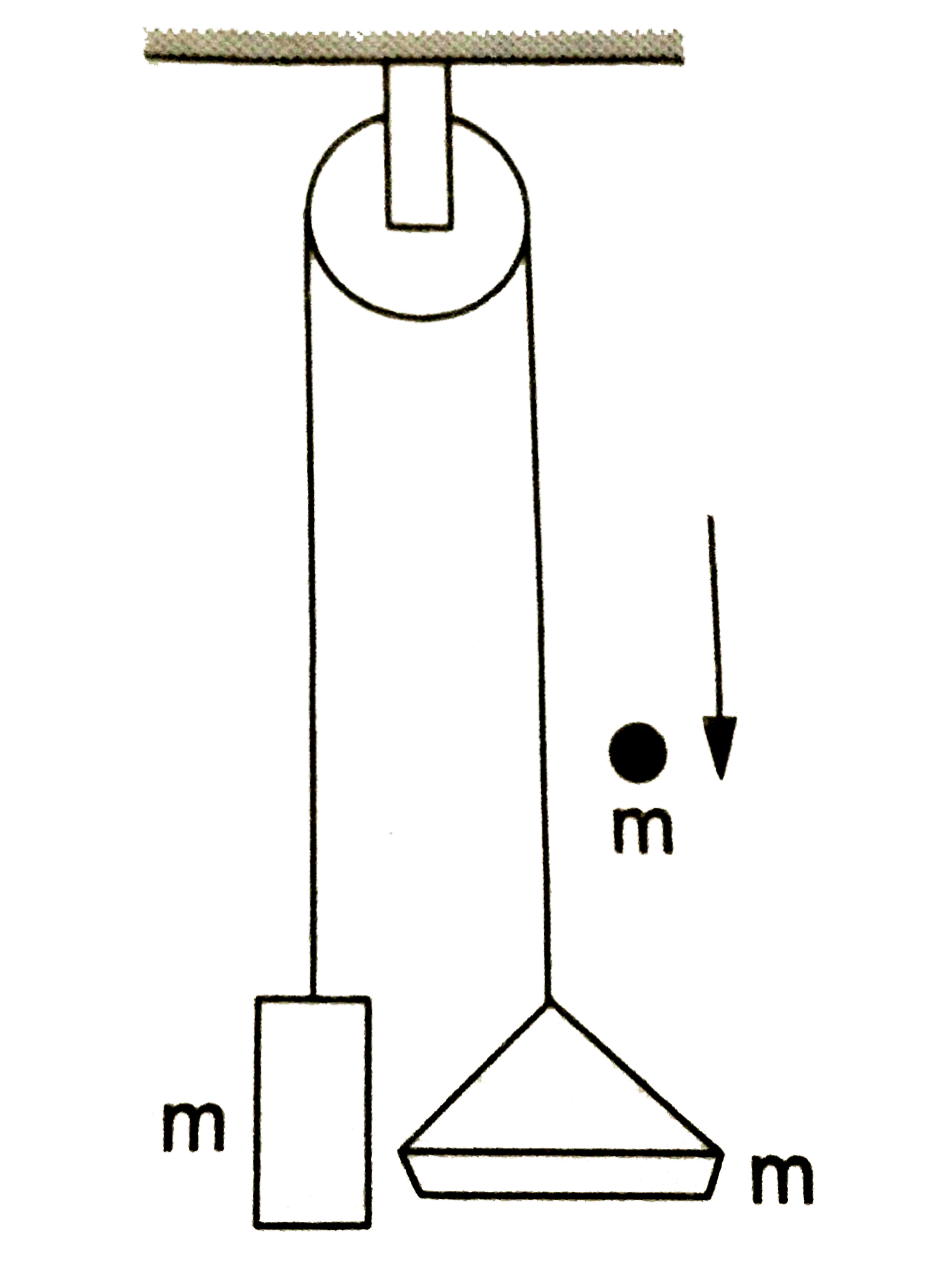 View Solution
View SolutionThe block of mass 3M is attached to the pulley system as shown in the figure. At t = 0, particle M falling vertically , strikes the block 3 M with velocity 8 m s−1 and sticks to it. The speed of the combined mass just after the collision is
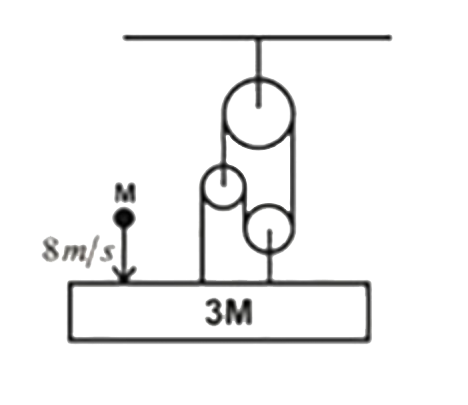 View Solution
View SolutionA particle of mass m moving with velocity v strikes a particle of mass 2m at rest and sticks to it. The speed of the combined mass is
01:28View SolutionA block of mass m and a pan of equal mass are connected by a string going over a smooth light pulley as shown in figure. Initially the system is at rest when a particle of mass m falls on the pan and sticks to it. If the particle strikes the pan with a speed v find the speed with which the system moves just after the collision.
View SolutionA block of mass m and a pan of equal mass are connected by a string going over a smooth light pulley. Initially the system is at rest when a particle of mass m falls on the pan and sticks to it. If the particle strikes the pan with a speed v, find the speed with which the system moves just after the collision.
04:32View SolutionA ball of mass M and a pan of mass m (m<M) are attached to the ends of a light inextensible string, passing over a smooth light pulley. The ball rests on a horizontal surface, with the pan hanging. A small particle of mass m collides elastically with the pan, falling from above, with a velocity v. Determine the instantaneous velocity of the ball, as it leaves contact with the surface. Find also the velocity with which the particle rebounds.
 03:44View Solution
03:44View Solution

